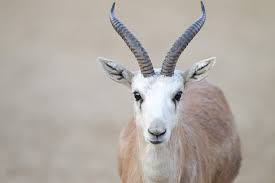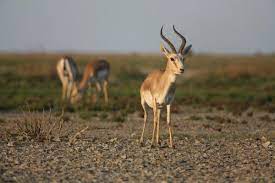In the vast and arid landscapes of Central Asia, a graceful creature known as the goitered gazelle roams, captivating with its elegance and ability to thrive in harsh conditions. Join us on a journey to delve into the captivating world of the goitered gazelle, uncovering its unique traits, habitat, and its crucial role in the delicate balance of its desert ecosystems.

The goitered gazelle, scientifically known as Gazella subgutturosa, stands as a symbol of adaptability and survival in desert environments. Its distinctive appearance and behaviors make it a subject of both scientific interest and admiration.
Distinctive Characteristics
The goitered gazelle is recognized for its slender build, white rump patch, and the distinctive goiter-like enlargement on its neck. These adaptations help it survive in arid conditions.
Habitat and Distribution
These gazelles inhabit a variety of desert landscapes across Central Asia and the Middle East. Their ability to traverse vast distances and adapt to challenging conditions is a testament to their resilience.
Behavior and Adaptations
Goitered gazelles have evolved unique adaptations to cope with desert life, including efficient water conservation and the ability to tolerate high temperatures.
Social Structure and Movement
Goitered gazelles exhibit social behavior in small groups, known as harems, led by a dominant male. Their migratory behavior allows them to track water and forage resources.
Diet and Foraging Habits
As herbivores, goitered gazelles feed on a variety of desert vegetation, such as shrubs and grasses. Their selective feeding contributes to vegetation management in their habitat.
Conservation and Challenges
Habitat degradation, hunting, and competition with livestock pose threats to goitered gazelle populations. Conservation efforts aim to protect their desert habitats and address human-wildlife conflicts.
Ecosystem Role
Goitered gazelles play a role in shaping desert ecosystems by influencing vegetation growth and providing food for predators.
Cultural Significance
In some cultures, goitered gazelles have historical and cultural significance, often representing the resilience of life in harsh environments.
Future Prospects
Understanding the behavior and ecology of goitered gazelles is crucial for their conservation and the preservation of their delicate desert habitats.
Conclusion
The goitered gazelle, with its unique adaptations and role in desert ecosystems, reminds us of the beauty and diversity of life in extreme environments. As we explore the world of these graceful nomads, we gain a deeper appreciation for the intricacies of nature’s designs.



















Add Comment